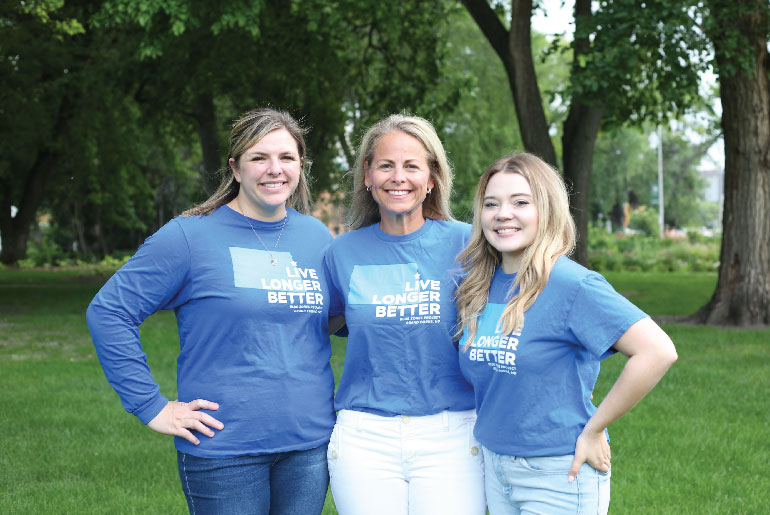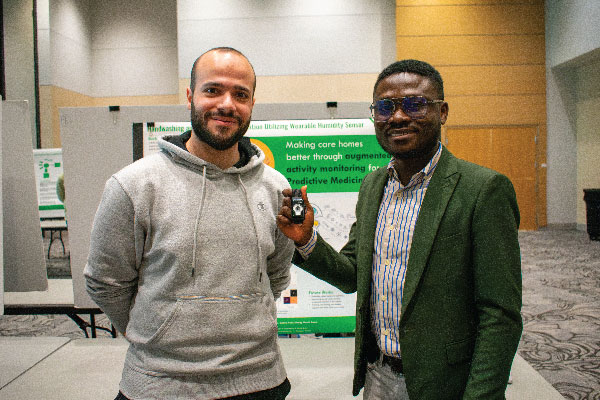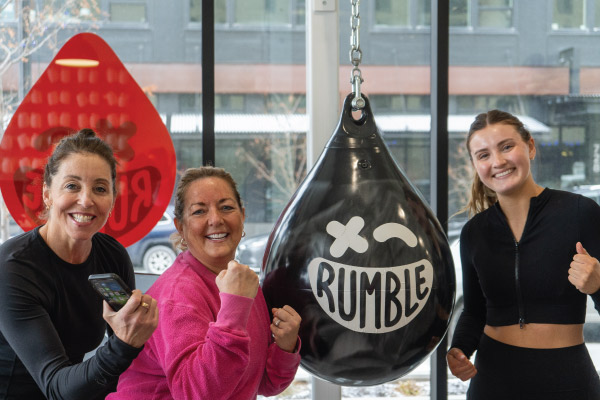Unlocking Longevity
Blue Zones Project brings world's healthiest lifestyles to North Dakota.
What does it take to live a long, healthy life? For the residents of Grand Forks, the answer might be in their own backyards.
Blue Zones Project Grand Forks (BZPGF) introduces simple, life-changing practices from the Blue Zones, areas of the earth where people live the longest, to the heart of North Dakota. Led by UND alumni Nicole Benson, ’24, Ashlee Kleveland, ’20, and Whitney Miller, ’20, this initiative aims to transform local health habits.
“The Blue Zones teach us that small, simple habits are the key to longevity,” explained Whitney, the project’s engagement marketing lead. “We’re following the nine habits of the residents of the places with the world’s longest-living individuals. The ‘Power 9’ are practices anyone can adopt to potentially add years to their life.”
“Power 9” was coined by National Geographic Fellow Dan Buettner. He discovered it is not unique genes but “an interconnected web of lifestyle characteristics” that promote health and longevity. For the last year and a half, the Grand Forks team has been working to make these practices accessible and easy for its residents to adopt.
The Power 9
- Move Naturally: Move more and burn calories without thinking about it.
- Purpose: Wake up with purpose each day.
- Downshift: Reverse disease by finding a stress-relieving strategy that works for you.
- 80% Rule: Eat mindfully; stop when 80% full.
- Plant Slant: Put more fruits and vegetables on your plate.
- Friends @ Five: Schedule social time with friends at the end of the day.
- Belong: Join a faith-based community and regularly attend services.
- Positive Pack: Surround yourself with people who support positive behaviors and support you.
- Loved Ones First: Invest time with family, however that is defined by you.
We want to make sure our young people live to be 100 and thriving, and we want our elderly to be healthy.Nicole Benson, '24Director of community programs
Grand Forks Blue Zones Project
Blue Zones Project in Grand Forks
Nicole Benson, director of community programs and project leader, said the program is for everyone. “We want to make sure our young people live to be 100 and thriving, and we want our elderly to be healthy.”
By the end of the three-year, grant-funded project, the goal is for Grand Forks residents to enhance their well-being, demonstrated by reduced healthcare costs, increased productivity, and a higher quality of life. The Blue Zones Project team works with its sponsors Altru Health System and the North Dakota Department of Health and Human Services, and relies on local experts to provide practical recommendations for integrating Power 9 practices into daily life.
“The Blue Zones philosophy is a top-down, bottom-up approach,” said Kristi Hall-Jiran, ’90, chief philanthropy and partnership officer at Altru and chair of the BZPGF steering committee. “From the top, the research is done, the evidence is there, we’ve got toolkits and best practices. From the bottom up, the community decides who we are and where there is work to do.”
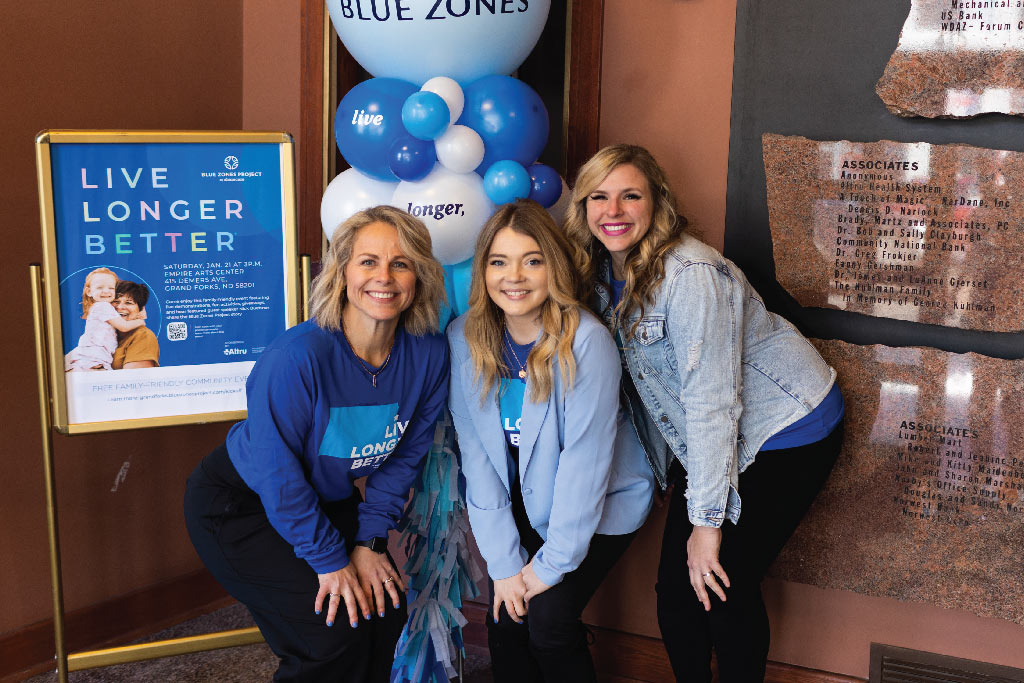
UND alumni Ashlee Kleveland, '20, Nicole Benson, ’24, and Whitney Miller, '20, were named the 2024 Public Health Team of the Year by the Center for Rural Health for their collaborative work on the Grand Forks Blue Zones Project.
Why Grand Forks? A Unique Opportunity
Grand Forks isn’t by the ocean, its temperatures are below freezing for several months
during the winter, and growing fresh produce is limited to spring and summer.
“A community can look very different and be successful,” Nicole said. “Change will
happen in baby steps.
“There are days when you can’t go for a walk outside because it’s too cold. We’ll have walking groups in the mall. It’ll look different, but we can do it. It truly is tailored to our Grand Forks priorities.”
Kristi said a strength of Grand Forks is its collaborative nature, fostered by the 1997 flood. “We had a major disaster. It forced us to figure out: How do we build partnerships? How do we recover? How do the business community and governmental partners and nonprofits work together?”
While there are more than 75 Blue Zones Project communities across the U.S., the first Blue Zones Project was piloted in Dan Buettner’s hometown, Albert Lea, Minnesota, a town similar to Grand Forks. Albert Lea has sustained better health, including a $7.5 million savings in annual health care cost for employers, since its 2009 implementation.
A community can look very different and be successful. Change will happen in baby steps.Nicole Benson
Overcoming Challenges and Building Community
Nicole acknowledges that capacity of BZP Grand Forks, focused on the city’s north side, is a challenge. “You want to do it all. Saying no is probably the toughest part,” she said.
“We aim to be the first community to complete the project in three years,” Nicole said. “This is particularly challenging for policy work, but I’m optimistic. We have the community support, and the organizations have been wonderful in their buy-in.”
With only three employees, BZPGF relies on its committees and volunteers. “Volunteering goes beyond the service you’re doing,” Whitney said. “You meet like-minded individuals, gain a sense of belonging and purpose, and give back to your community.”
Danielle Masursky, whose wardrobe includes a regular rotation of paint-splattered BZP t-shirts, joined the Engagement Committee when she moved to Grand Forks in 2022. “It’s been a great way to get to know and meet people engaged in the community. I’ve learned a lot about Grand Forks.”
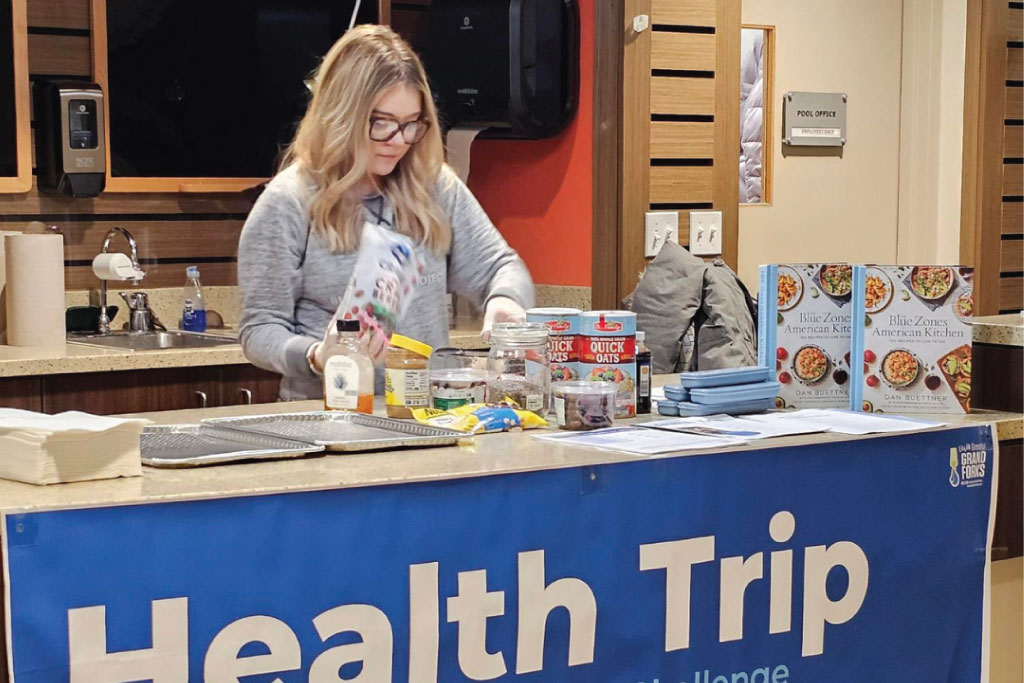
Cooking workshops introduce healthy recipes that fall in line with Power 9. "Plant Slant" encourages all to put more fruits and vegetables on their plates.
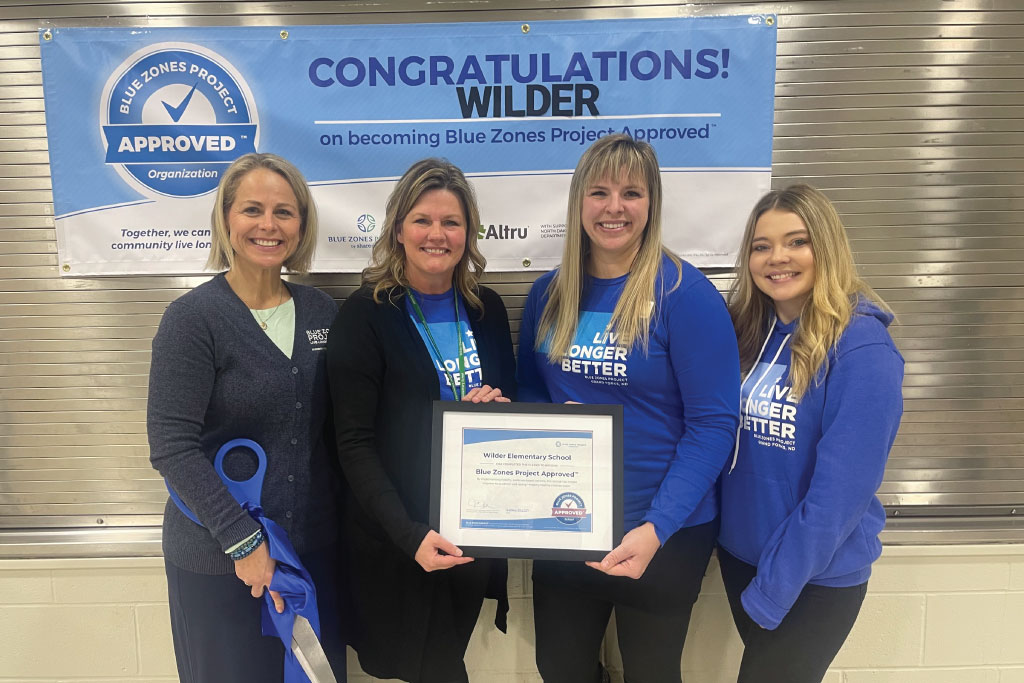
Wilder Elementary School is Blue Zones Project Approved™. BZPGF targets schools to ensure students’ physical, nutritional, mental, and social well-being.
Targeting Change: People, Places & Policy
BZP Grand Forks focuses on people, places, and policy. Success in these areas will earn Grand Forks the title of “Certified Blue Zones Community.”
People: Empowering Individuals
Whitney emphasizes building personal relationships. “We organize community events like cooking classes (pictured above), walking groups, and purpose workshops, centered around the Power 9,” Whitney said.
BZP events promote “moai,” a term from Okinawa meaning gatherings for a common purpose, which is central to their community spirit and longevity.
Places: Transforming Spaces
Ashlee, the project’s organization lead, collaborates with local workplaces, schools, grocery stores, and restaurants. “Our group looks at an organization’s practices to find those opportunities where we could add more choices,” Ashlee said.
Nicole said, “The restaurant industry is facing a workforce shortage so they’re a
little nervous to add something else, but Ashlee does all the heavy lifting.”
BZP’s toolbox of possible changes includes not having salt shakers on the table, allowing
people to split an entree at no additional cost, and charging a small fee for soda
refills.
Similarly, small changes can also lead buyers to make healthier choices at grocery stores, like having healthy options on end caps (the end of the aisle) and promoting local produce and farmers.
BZP also targets schools to ensure students’ physical, nutritional, mental, and social well-being. Winship Elementary School started a walking group with a nearby resident center. “This intergenerational connection was so powerful that the groups kept getting together over the summer,” Nicole said.
Policy: Shaping Healthy Policies
Nicole focuses on critical areas like the built environment, food, and tobacco control. “The experts are community leaders and stakeholders. I bring them together to figure out our priorities and how we can collaborate,” she said.
Revitalizing Skidmore Park was considered by the Downtown Development Association last year. When the group did not select the park, BZPGF stepped in and got the park district, local residents, and the University Park Neighborhood together to launch the revitalization of the park.
“We’re bringing that space back to life, making sure people can bike and walk, and utilize the space,” Whitney said. “You see it every day when you’re driving downtown. Its high visibility makes it a huge win.”
Nicole has joined coalitions on tobacco, substance abuse, and drug-free communities, and is developing a local food council “to help set priorities and continue work long after Blue Zones Project is gone.”
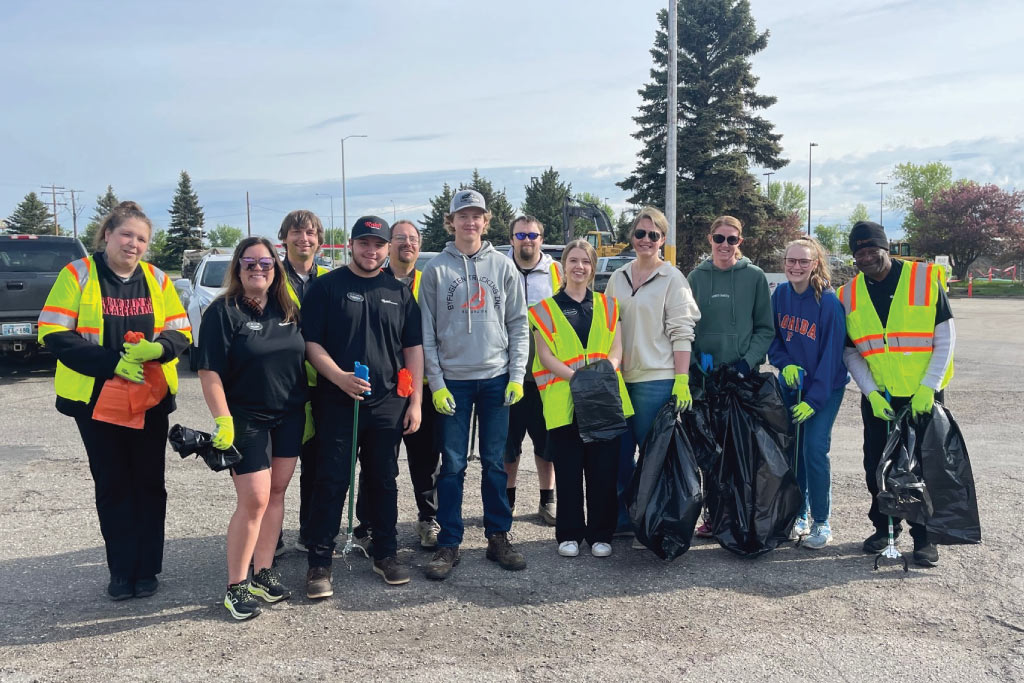
Volunteers meet for an adopt-a-highway clean-up event.
Engaging Major Employers
To meet its goals, BZPGF requires 10 of the top 20 employers in Grand Forks to become Blue Zones Project Approved™ worksites.
Altru is on the path to this designation, having recently established 16 walking groups and introducing healthier options in the cafeteria. “Healthcare is a hard place to find balance,” Kristi said. “You tend to find some of the hardest working and committed people, which can lead to not always putting yourself or your own health first.”
UND has been actively involved in Blue Zones activities. Last April, Communication students in Comm 430: Ad & PR Campaigns organized a Blue Zones event on campus to raise awareness and educate students about wellness practices.
Rylee Metz, ’24, worked on “Live by 9 with Blue Zones,” which featured restaurants, activities, and crafts presented by vendors and partners from both campus and the community.
The event exceeded expectations, with over 160 attendees. “What stuck with me was the emotional and verbal feedback,” Rylee said. “The UND students enjoyed it, asked questions, and genuinely became interested in Blue Zones.”
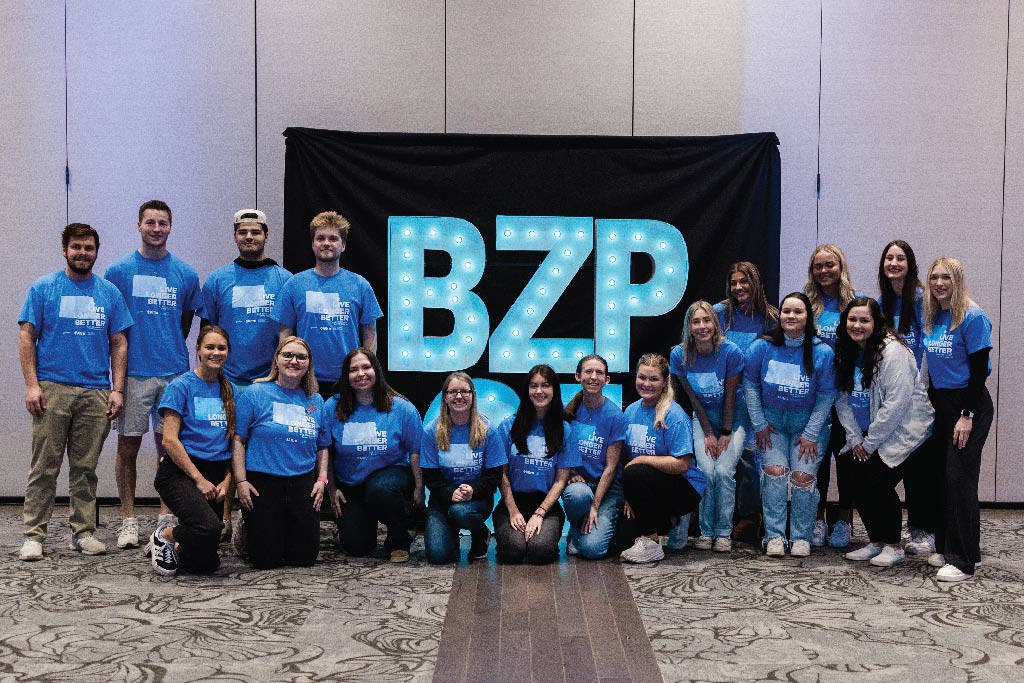
UND Comm 430 students educated the UND community about Blue Zones at an event they planned for class.
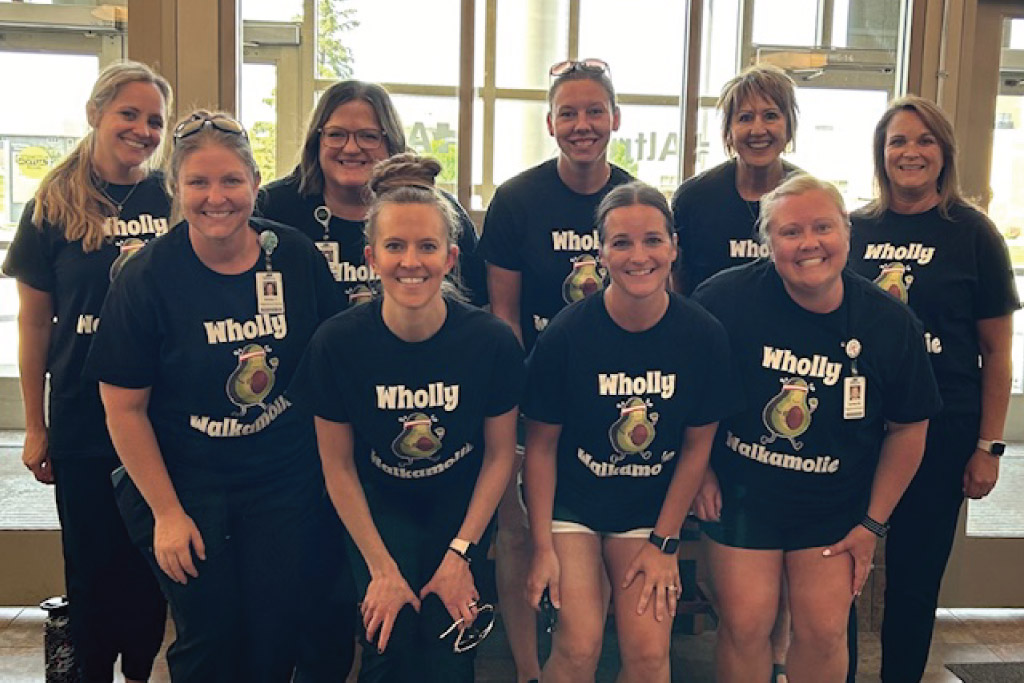
One of Altru's 16 walking groups gets ready for some exercise.
Powering Local Engagement
Blue Zones themes resonate with the community. “The beautiful part is people are engaged,” Kristi said. “The community is doing the work. They’re working in Skidmore Park, on bike policy, and building a new pickleball court. It’s so fun to see it.
“It doesn’t need me; it doesn’t need Altru,” she said. “We’re proud to support it, but the community is owning it.”

